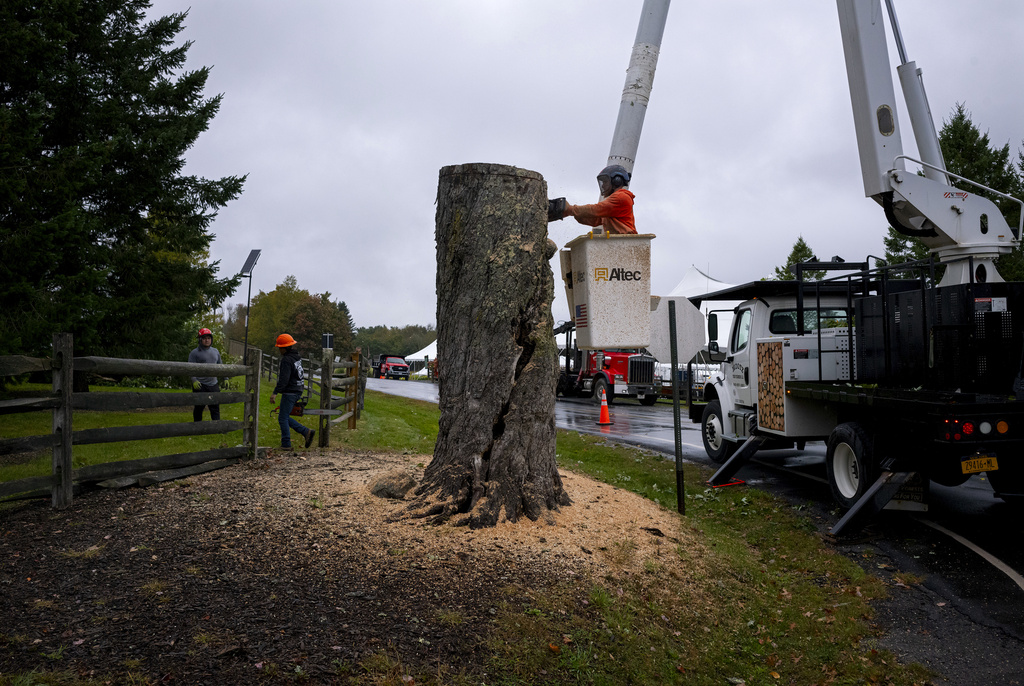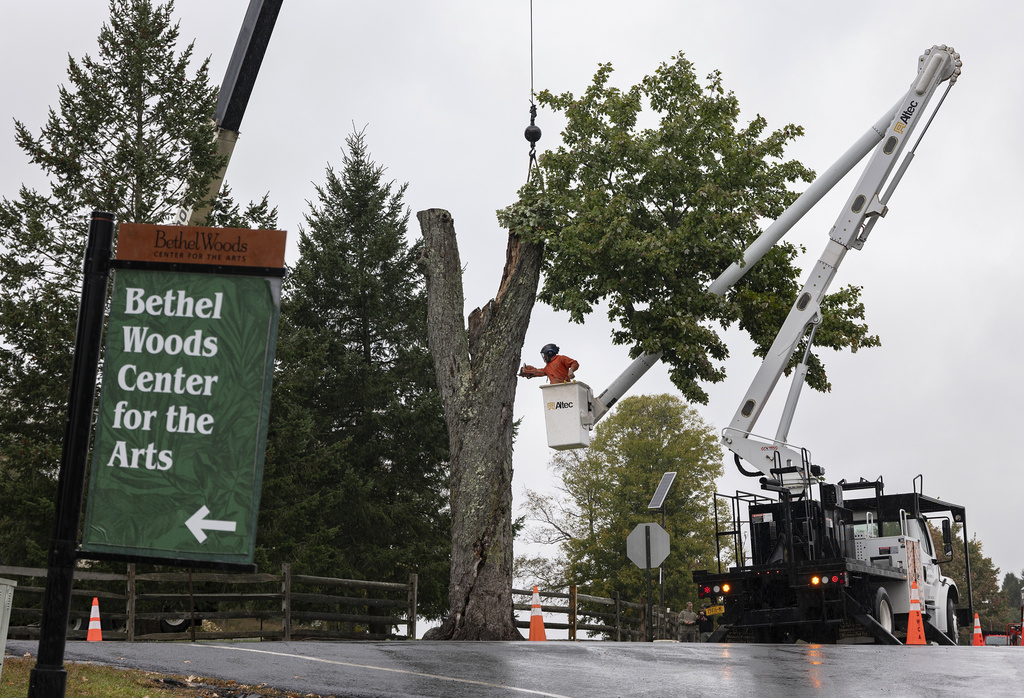Woodstock’s Historic Message Tree Removed After 55 Years \ Newslooks \ Washington DC \ Mary Sidiqi \ Evening Edition \ The historic “Message Tree,” a beloved landmark at the 1969 Woodstock festival, was removed due to poor health and safety concerns. The tree served as a meeting point for attendees and a symbol of the unity formed at the festival. Plans are underway to honor its legacy, including artwork from its wood and new saplings.

Woodstock’s Iconic Message Tree Removed After 55 Years Quick Looks:
- The iconic red maple, known as the “Message Tree” at Woodstock 1969, was cut down after 55 years due to health concerns.
- Located near the main stage, the tree was used by attendees to leave messages, helping people reconnect during the massive event.
- Messages like “Meet you here Saturday” and “Sorry I didn’t get your address” were among many left on the tree by festival-goers.
- The Bethel Woods Center for the Arts, which operates the historic site, made the difficult decision to remove the over 100-year-old tree for safety reasons.
- The Message Tree had become a nostalgic symbol of the festival’s sense of community, appearing in countless photos from the event.
- Bethel Woods plans to preserve the tree’s legacy by turning its wood into artwork, to be displayed at the on-site museum next year.
- The site also has saplings made from grafts of the original tree, and there are plans for a planting ceremony to replace the lost tree.
- Museum curator Neal Hitch expressed the emotional weight of losing such a significant piece of Woodstock history, calling it “both nostalgic and melancholy.”
Deep Look:
Fifty-five years after the iconic 1969 Woodstock festival, the beloved “Message Tree” has been cut down under gray, rainy skies, marking the end of an era. This towering red maple stood just off from the main stage and served as a meeting point for hundreds of festival-goers over that legendary weekend. As Woodstock drew an unexpected crowd of more than 400,000 people to Max Yasgur’s farm in Bethel, New York, attendees left messages on the tree, hoping to connect or reconnect with one another amidst the chaos.
This tree, later nicknamed the “Message Tree,” became more than just a physical landmark—it represented the essence of connection and community that Woodstock was known for. Festival-goers would scrawl messages on scraps of paper, cardboard, or even plates, attaching them to the tree’s trunk in hopes of reuniting with friends or making plans for the next event.
“SUSAN, MEET YOU HERE SATURDAY 11 A.M., 3 P.M. or 7 P.M.,” read one of the many notes attached to the tree’s rough bark. Another message was left for Candi Cohen, telling her to meet the girls back at the hotel. Dan, a hopeful festival attendee, used a paper plate to leave a message for Cindy, the woman with “black hair & sister,” apologizing for not being “together” enough to ask for her address, but leaving his number for her to call. These messages, etched in the lore of Woodstock, symbolize the free spirit and human connection that defined the festival and that time in history.
The Message Tree, a tall 60-foot (18-meter) red maple, was a natural gathering point for attendees navigating the sea of people in the days before cell phones or instant communication. For those at Woodstock, where rain and mud turned an already chaotic weekend into a symbol of survival and community, the tree represented a sense of order and connectivity. It stood as a silent sentinel, witnessing the monumental event unfold, and remained a tangible link to the iconic weekend for decades.
“The tree was one of the key markers of Woodstock,” said Neal Hitch, senior curator at The Museum at Bethel Woods, the modern-day museum and arts center built on the site of the original festival. Hitch pointed out that the tree was visible in countless photos from Woodstock, often appearing in the corner of images taken from the hill looking down toward the main stage. “It was literally in almost every picture someone took of the stage,” Hitch said. “So it is like the thing that has stood the test of time. To see that loss is both nostalgic and melancholy.”
Unfortunately, the Message Tree’s time had come. More than 100 years old, the tree had deteriorated, raising concerns about its health and the risk it posed to visitors. The Bethel Woods Center for the Arts, which now manages the historic site, reluctantly decided to remove the tree due to its advanced decay and potential danger of falling. Being located in a publicly accessible area, its condition had become a pressing safety issue. The decision to remove it was not made lightly, as it meant losing one of the few remaining living symbols of the Woodstock generation.
For Hitch and the team at Bethel Woods, watching the Message Tree come down was deeply emotional. “It’s like watching a loved one pass,” Hitch said, capturing the collective sense of loss felt by those who cherish Woodstock’s legacy. The tree, in many ways, represented the spirit of Woodstock—rooted in peace, love, and unity.
The tree had remained a steadfast presence long after the crowds dispersed and the muddy grounds were cleared. Over the years, the Message Tree continued to remind visitors of the festival’s ethos and served as a poignant reminder of how one weekend in 1969 changed culture and music forever. However, like everything, the tree had its limits. Before it was felled, the trunk still bore traces of the festival—nails and pins embedded deep within the bark from where notes and messages had been attached. Some of these messages are preserved today at the on-site museum.
While the physical tree is no longer standing, the team at Bethel Woods is committed to preserving its legacy. Plans are already in motion to honor the tree’s memory. Salvageable wood from the tree will be transformed into works of art, which will be exhibited at the museum next year. These pieces will serve as a tribute to the role the tree played at the festival, keeping its spirit alive for future generations.
But the efforts to commemorate the tree’s legacy don’t end there. Several saplings grown from grafts of the original Message Tree are already being nurtured at the site. These saplings are descendants of the iconic tree and represent the enduring nature of Woodstock’s values. Bethel Woods plans to host a regenerative planting ceremony in the near future, possibly planting one of these saplings where the original tree once stood.
“There’s this symbolism of planting something that will be the Message Tree for the next generation,” Hitch said, reflecting on the importance of continuing the tradition. “It will allow future visitors to experience the sense of connection and history that the original Message Tree provided.”
The removal of the Message Tree marks the end of a physical era, but its meaning continues to resonate. As visitors come to Bethel Woods in the years ahead, they will have new ways to connect with the site’s history. Whether through artwork crafted from its wood or the new sapling that may one day take root in its place, the Message Tree’s legacy will endure, echoing the sentiments of peace, love, and community that were so prevalent during those four days in 1969.
The Message Tree had quietly stood the test of time, serving as a natural landmark for decades after Woodstock. It witnessed the rise of a cultural movement that shaped generations and the historic performances of artists like Jimi Hendrix, Janis Joplin, and The Who. It was a meeting point, a message board, and ultimately, a symbol of unity for those who were part of that transformative moment in history.
Even though the original tree is gone, its essence will live on through art, memory, and the young trees that will soon take its place. As Hitch noted, the site of Woodstock has always been about more than just music—it’s about community, resilience, and hope for the future. The Message Tree was a living reminder of that, and now its legacy will continue to inspire.
Woodstock’s Historic Woodstock’s Historic Woodstock’s Historic Woodstock’s Historic







